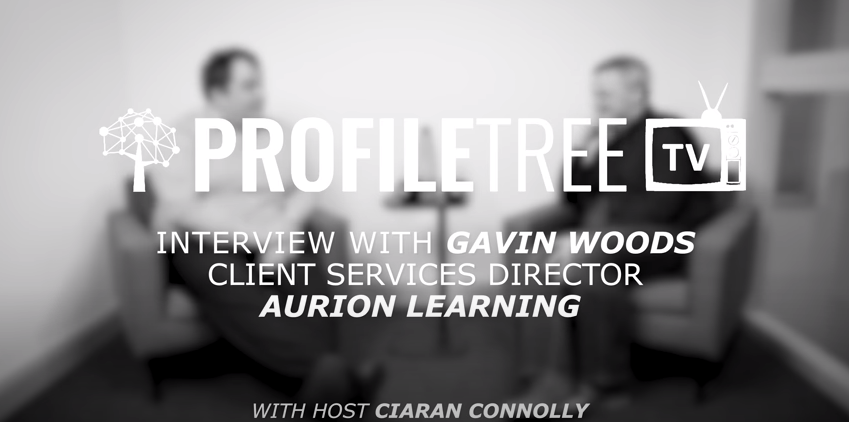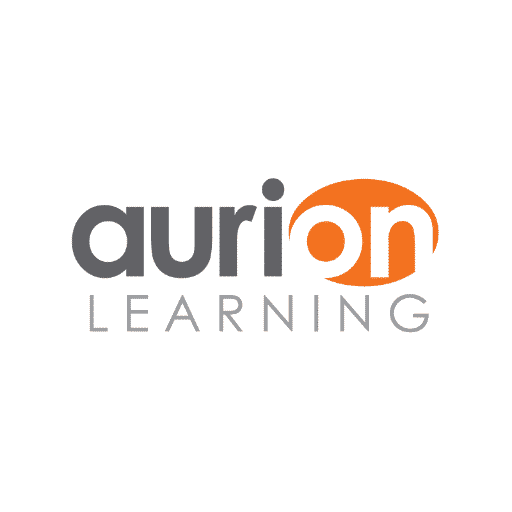E-learning has exploded in popularity across both academic and professional training landscapes. Online education offers unparalleled flexibility, scalability, and affordability compared to traditional in-person modes of teaching. Whether you want to coach students working towards degrees and certifications or train corporate employees in critical skills, developing an effective e-learning business strategy is crucial for success.
What can online learning do for your business? In our latest Business Leaders interview, we speak to Gavin Woods, Client Services Director of Aurion Learning, about e-learning and business strategy.
To discover more, watch our full interview with Gavin below, or read on for the highlights.
Table of Contents

What is Aurion Learning?
Aurion Learning is a solution-first company that focuses on making ongoing learning and development easy for its clients. It offers a full-service approach, creating custom eLearning solutions, blended learning materials and learning management systems to name a few.
The company works with a number of public and private organisations to meet a range of needs. Whether a client wants to improve quality, enhance performance, standardise training, cut delivery costs, meet compliance regulations, or simply make training more immersive, Aurion Learning is responsible for developing a solution that works through the use of online tools, one-to-one support and specialist technology.

Speaking about his own role, Gavin has always had a passion for education and learning.
“I have worked for around 15 years in software sales, mostly with an educational focus. It’s mostly working with both the public and private sector. My role is based around managing sales and marketing teams, plus engaging with clients.”
Since it opened in 2000, Aurion now has office headquarters based in Belfast, Dublin and Glasgow.

Learning With a Difference
Gavin explains that the work of Aurion Learning involves taking a fresh look at what learning can mean for an organisation.
“At Aurion Learning, we typically take an organisation’s content and give them advice, support, tools and technologies.
“We try to transform that content into online learning programmes that could be delivered to their staff and/or customers. It is very particular to the organisation we work with, meaning we help organisations expand their knowledge and their perception of what learning is in a tailored way.”
Providing a learning solution is not just about enabling teaching, it is about engaging people, invoking interest and problem solving – no matter the industry.
“We talk about learning that works – what problem is the organisation trying to solve? So we like to think we’re also problem solvers. That may be working with a national charity that wants to protect children. We’ll create materials that could be used in a classroom for teachers and the pupils.
“Or, we could be working with a leading corporation that wants to roll out very specialist knowledge about a product to their sales team, and we’ll help with that. We could even be working with a government body who wants to solve homelessness, which is a big project we’re working on at the moment. But all of these problems can be solved by robust eLearning.”

Understanding E-Learning: Embracing a Digital Path to Knowledge
E-learning, or electronic learning, has revolutionized the way we acquire knowledge. It’s the delivery of education and training through digital technologies, like computers, tablets, and mobile devices, without the physical presence of an instructor in a traditional classroom setting. But how does it differ from the classic chalk-and-board approach, and what benefits and challenges does it offer to both students and instructors?
Defining the Difference:
Traditional learning typically involves face-to-face interaction in a classroom, structured lectures, and physical textbooks. E-learning, on the other hand, embraces digital resources like online courses, videos, interactive modules, and virtual simulations. While both aim to impart knowledge and skills, the delivery method and learning experience diverge significantly.
Benefits for Students:
- Flexibility and On-Demand Access: E-learning offers unparalleled flexibility. Students can learn at their own pace, anytime and anywhere, with internet access. This caters to busy schedules, diverse learning styles, and geographical limitations.
- Personalized Learning: Many e-learning platforms utilize adaptive learning technologies, tailoring the content and pace to individual learning needs and progress. This personalized approach can enhance understanding and engagement compared to one-size-fits-all traditional methods.
- Diverse and Engaging Content: E-learning goes beyond passive lectures. Interactive modules, simulations, videos, and gamified elements keep students engaged and actively participate in the learning process. This can lead to better knowledge retention and practical application.
- Cost-Effectiveness: E-learning often carries lower costs compared to traditional education. Students save on transportation, accommodation (if applicable), and expensive textbooks. Additionally, instructors can reach a wider audience without geographical limitations, reducing venue and faculty costs.
- Global Access to Knowledge: E-learning transcends borders, providing access to high-quality education and training from renowned institutions and experts worldwide, regardless of location or socioeconomic background.
Challenges for Students:
- Self-Discipline and Motivation: E-learning requires self-discipline and time management skills. Students need to be proactive and motivated to engage with the material and stay on track, which can be challenging for some.
- Limited Interaction and Collaboration: The lack of face-to-face interaction can hinder peer-to-peer learning and collaboration, which are valuable aspects of traditional education. E-learning platforms need to incorporate tools and methods to foster online group work and interaction.
- Technical Issues and Access: Access to reliable internet and suitable technology can be a barrier for some students, especially in underserved communities. This digital divide needs to be addressed to ensure equitable access to e-learning opportunities.
Benefits for Instructors:
- Wider Reach and Scalability: E-learning allows instructors to reach a global audience beyond physical classroom limitations. This opens up potential for increased income and impact without geographical constraints.
- Diverse Teaching Methods and Resources: E-learning offers a plethora of tools and platforms to diversify teaching methods and enhance engagement. Instructors can utilize multimedia elements, simulations, and interactive content to cater to different learning styles and preferences.
- Greater Feedback and Analytics: E-learning platforms often provide detailed data and analytics on student progress and engagement. This allows instructors to tailor their teaching and provide individual feedback more effectively.
- Time Efficiency and Cost Savings: Preparing and delivering online courses can be time-efficient compared to traditional methods. Additionally, instructors can save on travel costs and classroom expenses associated with teaching physical classes.
- Continuous Improvement and Updates: E-learning content can be easily updated and improved based on student feedback and evolving industry trends. This allows instructors to provide the most relevant and up-to-date information to their learners.
Challenges for Instructors:
- Developing Effective E-Learning Content: Creating engaging and effective e-learning content requires different skills and expertise compared to traditional teaching methods. Instructors may need to invest in training and learn new tools to craft online materials.
- Technical Challenges and Maintenance: Managing online platforms, addressing technical issues, and ensuring smooth delivery of e-learning content can be complex. Instructors may need additional support and technical expertise to navigate these challenges.
- Adapting to Online Teaching: The dynamics of online teaching differ from traditional classrooms. Instructors need to develop engaging communication approaches, foster online communities, and effectively manage student interaction remotely.
The Importance of Blended Learning
The way we learn has changed drastically over the last year – let alone decade. But with these changes, come a more person-centred approach. Gavin outlines the changes he had seen in recent years, particularly around blended learning.
“For blended learning, I always use the analogy of ‘if learning is a pizza, then the blend is the toppings’. There are many different types of content, approaches and training delivery models – and it’s going to be whatever works best for different organisations, for how learners want to learn.
“For example, if you’re a haulage company with a fleet of drivers out on the road, having classroom training for them isn’t the most efficient way of learning. But, if you offer something that is maybe video-based learning, they can look at it on their own device while out and about, which may be a better way for them to learn.”
For more information about Aurion Learning, online learning and business strategy, check out our full Business Leaders series video interview. Or you can visit Aurion Learning’s official website for more about its services.
E-Learning Trends and Innovations: Shaping the Future of Your Business
The world of e-learning is constantly evolving, with exciting trends and innovative technologies emerging, promising to revolutionize the way we learn and teach. By embracing these trends, you can future-proof your e-learning business and stay ahead of the curve. Let’s explore some key trends and how they can impact your strategy:
1. Microlearning:
- What it is: Bite-sized learning modules focused on specific skills or knowledge chunks, usually consumed in under 10 minutes.
- Impact: Ideal for busy learners and attention spans, microlearning improves knowledge retention and just-in-time learning needs.
- Strategic Implications: Develop microlearning modules as standalone assets or integrate them into larger courses. Optimize for mobile delivery and consider gamification for higher engagement.
2. Personalized Learning:
- What it is: Tailoring learning content and paths to individual needs, learning styles, and pace. This often involves AI-powered algorithms.
- Impact: Enhances learner engagement and knowledge comprehension, leading to better outcomes and higher completion rates.
- Strategic Implications: Invest in adaptive learning platforms or develop personalized content tracks based on learner data and assessments. Offer customization options and encourage self-directed learning.
3. Adaptive Learning:
- What it is: AI-powered systems that adjust content and learning pathways based on individual performance and responses in real-time.
- Impact: Maximizes efficiency by automatically identifying gaps and providing targeted remedial content, ultimately reducing learning time.
- Strategic Implications: Integrate adaptive learning functionalities into your platform or courses. Collect and analyze learner data to optimize content and personalize learning paths.
4. Augmented Reality (AR):
- What it is: Overlaying digital elements onto the real world through devices like headsets or smartphone cameras, creating immersive learning experiences.
- Impact: Brings abstract concepts to life, enhances engagement, and promotes practical skill development through interactive simulations and scenarios.
- Strategic Implications: Explore incorporating AR elements into your courses to create interactive simulations, virtual labs, or field training scenarios. Partner with AR development companies or utilize ready-made AR tools.
5. Other Emerging Trends:
- Social Learning: Fostering online communities where learners can collaborate, share experiences, and provide peer-to-peer support.
- Mobile Learning: Optimizing content and delivery for mobile devices, catering to learners on the go.
- Content Curation: Aggregating and filtering high-quality content from various sources to offer a comprehensive learning experience.
Adapting Your Business Strategy:
- Analyze your target audience: Identify their learning needs, preferences, and access to technology to choose the most relevant trends to implement.
- Assess your resources: Evaluate your budget, technical expertise, and existing content to determine the feasibility of incorporating new technologies.
- Pilot and iterate: Start small with pilot projects to test the effectiveness of new trends and gather feedback before full-scale implementation.
- Stay informed: Continuously research and analyze emerging trends to ensure your e-learning business remains at the forefront of innovation.
Engaging Learning: Demystifying E-Learning Content Formats
The heart of any e-learning journey lies in its content. But in this digital realm, diversity is key. Gone are the days of dry text-heavy modules. Modern e-learning thrives on a vibrant mix of formats, each catering to different learning styles and objectives. Let’s explore the captivating world of e-learning content formats and guide you in choosing the perfect blend for your audience and goals.
1. Visual Storytelling:
- Videos: From short explainers to captivating documentaries, videos excel at engaging your learners and making complex concepts digestible. Animations, motion graphics, and live-action segments can each add unique layers of impact.
- Infographics: Compress complex data into visually appealing and clear infographics. They’re ideal for summarizing key takeaways and adding visual punch to dense information.
2. Interactive Learning:
- Interactive Modules: Put the “e” in e-learning with interactive modules. Gamified elements, simulations, and branching scenarios keep learners engaged and actively apply their knowledge.
- Quizzes and Assessments: Don’t just assess, make it an engaging experience! Interactive quizzes with immediate feedback and personalized learning paths offer valuable self-reflection and knowledge validation.
3. Written Content:
- E-books and Articles: While often overlooked, well-structured e-books and articles can offer in-depth information and reference materials for self-paced learning.
- Case Studies and Real-World Examples: Bring theory to life through relevant case studies and real-world examples. This helps learners grasp concepts and see their practical application.
Choosing the Right Format:
- Consider your audience: Understand their preferred learning styles (visual, auditory, kinesthetic) and their tech comfort level.
- Align with learning objectives: What skills or knowledge do you want learners to gain? Choose formats that best facilitate their acquisition.
- Variety is key: Don’t get stuck in a rut! A mix of formats keeps learners engaged and caters to diverse preferences.
- Accessibility matters: Ensure all formats are accessible for learners with disabilities. Captions, transcripts, and alternative text are essential.
Additional Tips:
- Microlearning: Break down complex topics into bite-sized modules for enhanced retention and mobile learning.
- Storytelling: Weave a narrative thread through your content to keep learners invested and emotionally connected.
- Interactivity is king: Interactive elements like polls, discussions, and gamification boost engagement and knowledge application.
- Visual appeal: Invest in high-quality graphics, audio, and video production for a professional and engaging experience.
The Future of E-Learning: Where Innovation Meets Transformation
The realm of e-learning is far from static. It’s a dynamic frontier constantly pushing the boundaries of education, evolving at a breathtaking pace. So, where are we headed? What exciting possibilities lie ahead? Let’s glimpse into the crystal ball and explore the future trajectory of e-learning:
1. Immersive Learning: Buckle up for virtual field trips and hands-on simulations! Technologies like AI, VR, and AR will redefine learning experiences, transporting students to immersive environments where they can explore, experiment, and apply knowledge like never before. Imagine dissecting a virtual frog in biology class or scaling Mount Everest in geography!
2. Hyper-Personalization: One-size-fits-all is out, personalized learning is in! Powered by advanced data analytics and adaptive technology, e-learning will cater to individual needs and learning styles like never before. Imagine learning paths that adjust to your pace, strengths, and weaknesses, ensuring optimal engagement and knowledge retention.
3. Microlearning on the Go: Bite-sized knowledge nuggets delivered on-demand wherever, whenever? That’s the future of microlearning. Imagine acquiring new skills and mastering complex concepts during your commute, in between tasks, or even during a workout! Learning will become seamlessly integrated into everyday life, maximizing efficiency and accessibility.
4. Artificial Intelligence as Mentor: Say hello to your AI learning companion! AI-powered virtual tutors will provide personalized guidance, answer questions in real-time, and offer adaptive feedback, ensuring no learner gets left behind. Imagine AI mentors that adjust their teaching style to your learning preferences, providing constant support and encouragement.
5. Democratizing Education: E-learning has the potential to bridge geographical and socioeconomic gaps, making quality education accessible to all. Imagine remote villages in Africa accessing world-class courses taught by renowned professors, or underserved communities gaining the skills they need to thrive in the global economy.
Embracing the Future:
The future of e-learning is brimming with possibilities. To stay ahead of the curve, remember:
- Stay informed: Follow industry trends, explore emerging technologies, and be open to learning new things.
- Embrace innovation: Don’t be afraid to experiment, try new tools, and incorporate innovative approaches into your e-learning offerings.
- Focus on learner needs: Always keep your audience in mind. Cater to their diverse needs, learning styles, and preferences.
- Adapt and evolve: Be flexible and agile. The future of e-learning is dynamic, so be prepared to adapt your approach as new technologies and trends emerge.
FAQs:
- What are the benefits of e-learning for students?
- Flexibility and on-demand access to learning materials.
- Personalized learning tailored to individual needs and pace.
- Diverse and engaging content formats.
- Cost-effectiveness compared to traditional education.
- Global access to knowledge and renowned educators.
- What are the challenges of e-learning for students?
- Self-discipline and motivation required for self-directed learning.
- Limited interaction and collaboration compared to traditional classrooms.
- Technical issues and access to reliable internet and technology.
- What are the benefits of e-learning for instructors?
- Wider reach and global audience beyond geographical limitations.
- Diverse teaching methods and resources to enhance engagement.
- Detailed data and analytics on student progress and engagement.
- Time efficiency and potential cost savings compared to traditional teaching.
- Continuous improvement and updates to online courses.
- What are some emerging trends in e-learning?
- Microlearning: Bite-sized learning modules for on-the-go learning.
- Personalized learning: AI-powered adaptive learning paths tailored to individual needs.
- Gamification: Interactive elements and rewards to boost engagement.
- Augmented reality: Immersive learning experiences through digital overlays on the real world.
- Social learning: Online communities and peer-to-peer learning opportunities.
- How can I choose the right LMS for my e-learning needs?
- Consider your audience size, learning objectives, budget, and desired features.
- Evaluate ease of use, scalability, integrations with other tools, and support services.
- Research and compare different LMS options before making a decision.
Conclusion:
E-learning is not just a trend; it’s a revolution in education. By embracing its potential, we can create a future where learning is accessible, engaging, and personalized for everyone. So, unlock the door to the e-learning world, explore its possibilities, and join the journey towards a transformative future of education!
Become a Part of Our Business Leaders Series
Interested in featuring on our Business Leaders series? In our acclaimed series, we share amazing advice, tips and stories from business owners, managers and senior leaders.
From growing your business to looking after your staff, new industry insights and innovative ideas – we cover everything to inspire professionals across all sectors. If you want to become a part of it, simply drop us a message.


